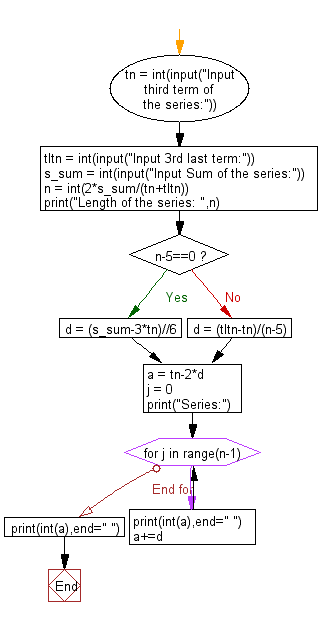Python: Print the length of the series and the series from the given 3rd term, 3rd last term and the sum of a series
Series Length and Terms
Write a Python program to print the length of the series and the series from the given 3rd term, 3rd last term and the sum of a series.
Let X and Y denote the third and the third last term of the arithmetic progression respectively i.e. X=a+2d and Y=a+(n−3)d where a, d and n are what you would expect them to be. Note that we are given X and Y Now, we are also given the sum of the n terms i.e. S=n2[2a+(n−1)d] ⇒S=n2[(a+2d)+(a+(n−3)d)] ⇒S=n2[X+Y] ⇒n=2SX+Y Having computed n, we can plug back it's value in the expression for Y. This will give us 2 equations in 2 unknowns (a and d) which we can solve to determine the remaining variables. X=a+2d and Y=a+(2SX+Y−3)d Reference: https://bit.ly/2N2VM9f
Sample Data:
Input third term of the series: 3
Input 3rd last term: 3
Input Sum of the series: 15
Length of the series: 5
Series:
1 2 3 4 5
Sample Solution:
Python Code:
# Input the third term of the series
tn = int(input("Input third term of the series:"))
# Input the 3rd last term
tltn = int(input("Input 3rd last term:"))
# Input the sum of the series
s_sum = int(input("Sum of the series:"))
# Calculate the length of the series using the formula for the sum of an arithmetic series
n = int(2 * s_sum / (tn + tltn))
print("Length of the series: ", n)
# Calculate the common difference 'd' based on the length of the series
if n - 5 == 0:
d = (s_sum - 3 * tn) // 6
else:
d = (tltn - tn) / (n - 5)
# Calculate the first term 'a' using the third term and common difference
a = tn - 2 * d
j = 0
# Print the series
print("Series:")
for j in range(n - 1):
print(int(a), end=" ")
a += d
print(int(a), end=" ")
Sample Output:
Input third term of the series: 3 Input 3rd last term: 6 Sum of the series: 36 Length of the series: 8 Series: 1 2 3 4 5 6 7 8
More Sample Output:
Input third term of the series: 3 Input 3rd last term: 3 Sum of the series: 15 Length of the series: 5 Series: 1 2 3 4 5
Explanation:
Here is the breakdown of the above Python exercise:
- User Input:
- tn = int(input("Input third term of the series:")): Takes user input for the third term of the arithmetic series.
- tltn = int(input("Input 3rd last term:")): Takes user input for the third-last term of the arithmetic series.
- s_sum = int(input("Sum of the series:")): Takes user input for the sum of the arithmetic series.
- Calculate Series Length:
- n = int(2 * s_sum / (tn + tltn)): Calculates the length of the arithmetic series using the sum formula.
- Calculate Common Difference:
- Determines the common difference 'd' based on the length of the series.
- If n - 5 == 0, it sets d = (s_sum - 3 * tn) // 6.
- Otherwise, it sets d = (tltn - tn) / (n - 5).
- Calculate First Term:
- a = tn - 2 * d: Calculates the first term 'a' of the arithmetic series using the third term and common difference.
- Print Series:
- Prints the arithmetic series using a loop and the calculated first term and common difference.
Flowchart:

For more Practice: Solve these Related Problems:
- Write a Python program to compute the mean and median of a series given its first and last terms along with the total sum.
- Write a Python program to verify if a series is arithmetic given its second term, second last term, and total sum.
- Write a Python program to calculate the common difference of an arithmetic series based on partial series information.
- Write a Python program to reconstruct an arithmetic series when given the sum, number of terms, and one specific term.
Go to:
Previous: Write a Python program to find the type of the progression (arithmetic progression/geometric progression) and the next successive member of a given three successive members of a sequence.
Next: Write a Python program to find common divisors between two numbers in a given pair.
Python Code Editor:
Have another way to solve this solution? Contribute your code (and comments) through Disqus.
What is the difficulty level of this exercise?
Test your Programming skills with w3resource's quiz.
